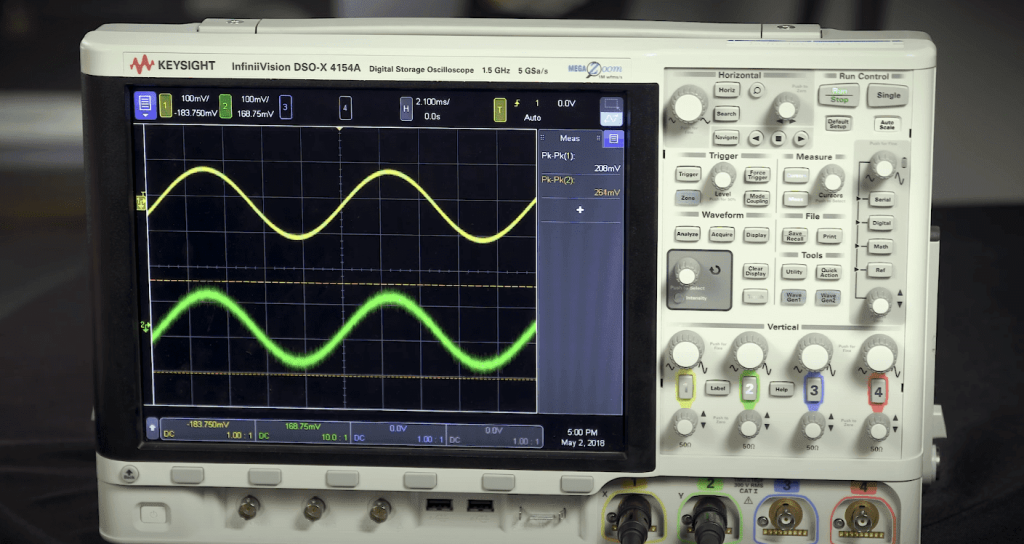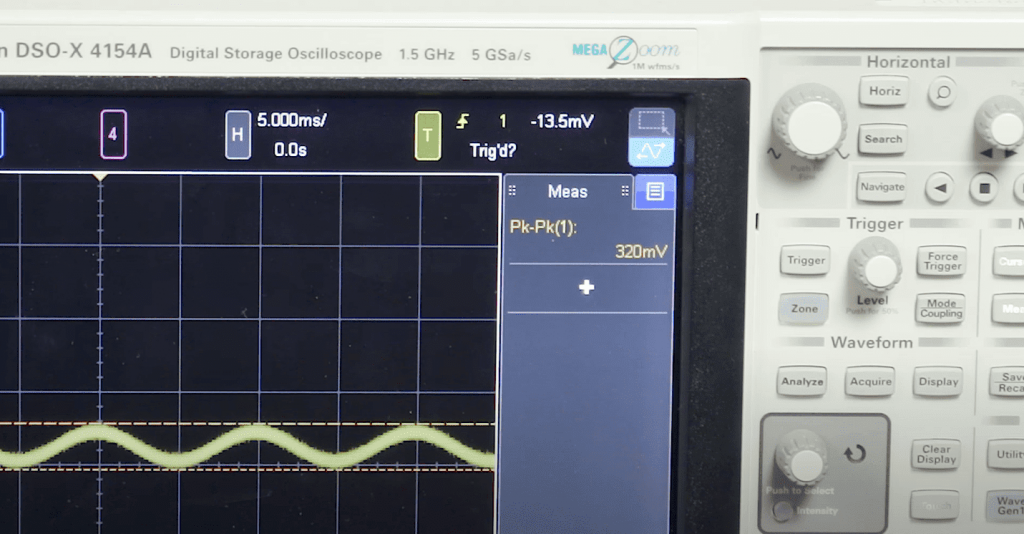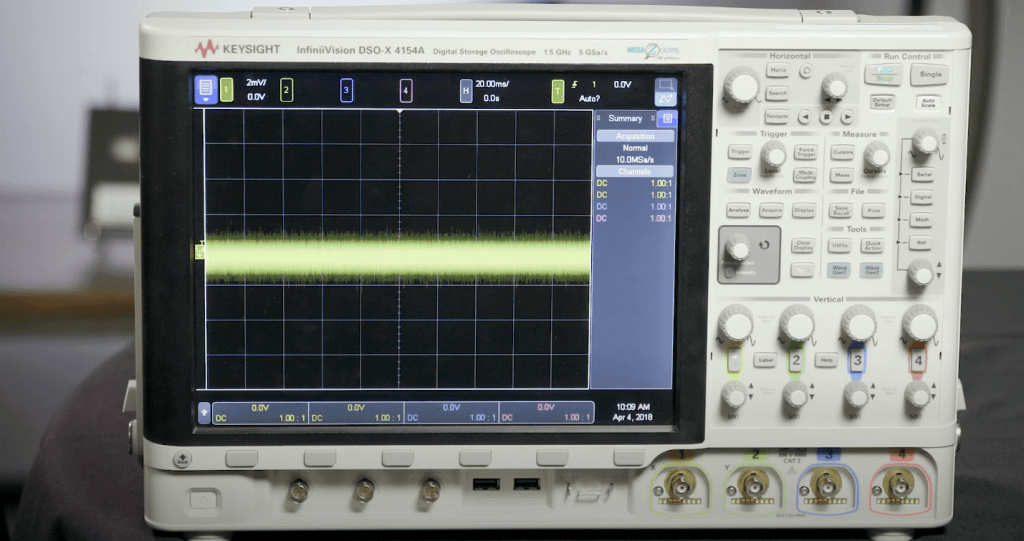Noise is an unwanted signal that a number of sources can cause. In this article, we will discuss the different types of noise that you might encounter and how you can reduce them. We will also provide some ways to reduce noise in oscilloscope measurements.
Why Does Noise Occur on Oscilloscopes?
Oscilloscope noise is a common issue that happens when you are trying to record an electrical signal or view the waveform. Noise on oscilloscopes can be caused by a number of factors, including mechanically generated vibration, power supply ripple or ground bounce, or movement in the probe tip.
The main cause of the noise is due to non-linearity in the circuit’s behavior. Non-linear circuits show a different output for different input values, which makes them hard to predict what will happen next, and this can lead to noise in the circuit.

The oscilloscope noise is not just an inconvenience, it can also affect your measurements, so it’s important to understand what causes it and how to fix it.
What are the Different Ways to Remove Noise from Oscilloscopes?
There are three main ways to remove noise from an oscilloscope.
- The most obvious solution is to use a digital oscilloscope with a wide bandwidth, low intrinsic noise, and a high sampling rate for measurements. Oscilloscope models with bandwidths up to 500 MHz are most in demand. Some applications require a little more or do with less bandwidth.
- Averaging. The mathematical buffer adds up the values of N samples and divides them by the number of samples N. When the desired level of noise reduction is reached, the user can view the shape of the averaged signal and make measurements. This is a well-known method available in most oscilloscopes. However, there are a number of limitations to this method. It does not work with a non-periodic and unstable signal. Measurements of rising time, pulse width, single pulses, and other parameters will be altered by removing part of the signal. “True” noise, which is part of the signal, will also be removed.
- Filtering. Analog and digital filters are built into many models of oscilloscopes from various manufacturers. This method is not based on the presence of a periodic signal or on stable synchronization. The advantages of this method are that the user has more flexibility in the filter settings and can remove high-frequency noise while leaving low-frequency noise. Also, in most cases, the real signal can be observed at the same time as the signal passes through the filter.
Reducing Noise in Oscilloscope: Expert’s Opinion
A basic concept that engineers learned a long time ago is that if there is spurious noise at the input, there will be spurious noise at the output as well. Suppose the oscilloscope adds a significant amount of noise to the signal during data acquisition. In that case, the display and measurement of the signal are likely to be incorrect after processing as well. Tools such as averaging and filtering will also be ineffective. On the other hand, if the oscilloscope performs clean data acquisition, it is much more likely that the user can apply the analytical capabilities of the oscilloscope and get the correct solution.

FAQ
How is electrical noise measured?
Electrical noise is a common issue for many technology devices, including computers, televisions, and power lines. This can cause interruptions or errors in digital systems. There are two ways to measure electrical noise: using an oscilloscope or using an electromagnetic spectrum analyzer.
Does oscilloscope calibration remove noise?
Oscilloscope calibration does not remove noise. Noise is inherent to any measurement system. If you are measuring something like the voltage, then the only way to get rid of noise is to use a different method.
How does modulation reduce noise?
Modulation is a method of reducing noise or interference by using a signal, typically an audio signal, to control the amplitude or frequency of another signal.
What is electrical noise called?
Electrical noise is a type of electronic interference that can be detected by measuring the voltage fluctuations on an AC power line. It can also be called flicker noise or electric field noise.
What is RF noise?
RF noise is an electrical signal that is generated by electronic devices. This can include signals from your computer, television, radio, microwave ovens, cordless phones, etc. These are all examples of electromagnetic radiation (EMR) that is emitted by these devices.
Are there noises in the Siglent SDS1202X-E oscilloscope?
The noise in the Siglent SDS1202X-E oscilloscope is largely the result of its advanced digital circuitry that converts the analog signals into digital format.
Are there noises in the Rigol DS1054Z oscilloscope?
There are noises in the Rigol DS1054Z oscilloscope, but they are very low in volume. The noise is created by the internal circuitry of this device that is required for functioning properly.
Are there noises in mixed-signal oscilloscopes?
Mixed-signal oscilloscopes are usually noisy, which can cause problems when trying to measure the frequency of a signal. However, some mixed-signal oscilloscopes can be noise-free and provide excellent measurement capabilities.
Video Tutorial: How to Decrease Noise in Your Signals?
Conclusion
In this article, we have discussed how to reduce noise in an oscilloscope. We also talked about what these tools are and how they can be used.
Thanks for reading!








I was always fascinated by electronics and the inner workings of machines. As a child, I would often take apart gadgets to see how they worked, much to my parents’ dismay. So, it’s no surprise that I ended up working as an engineer. Part of my job is using an oscilloscope to measure electrical signals.
I was recently troubleshooting a noise issue on one of our production lines. I was using the oscilloscope to measure the electrical signal and I noticed that the signal was very noisy. After some investigation, I found that the problem was caused by a loose wire.
I was able to fix the problem and prevent it from happening again in the future. It’s moments like these that make me love my job. Being able to solve problems and help keep things running smoothly is what it’s all about for me.
As an electrical engineer, I often have to find ways to reduce noise in a signal. Oscilloscopes are one of the most important tools that I use to do this. By using an oscilloscope, I can quickly see where the noise is coming from and then take steps to reduce it.
In many cases, the first step is to identify the source of the noise. This can be done by looking at the waveform on the oscilloscope. If the noise is coming from a particular component, then that component can be replaced or removed.
Another way to reduce noise is to add filters. Filters can be used to remove unwanted frequencies from a signal. This can be especially helpful if the noise is coming from AC power lines or other sources of electromagnetic interference.
Finally, it is also possible to shield components from electromagnetic interference.
Thanks for sharing, James!